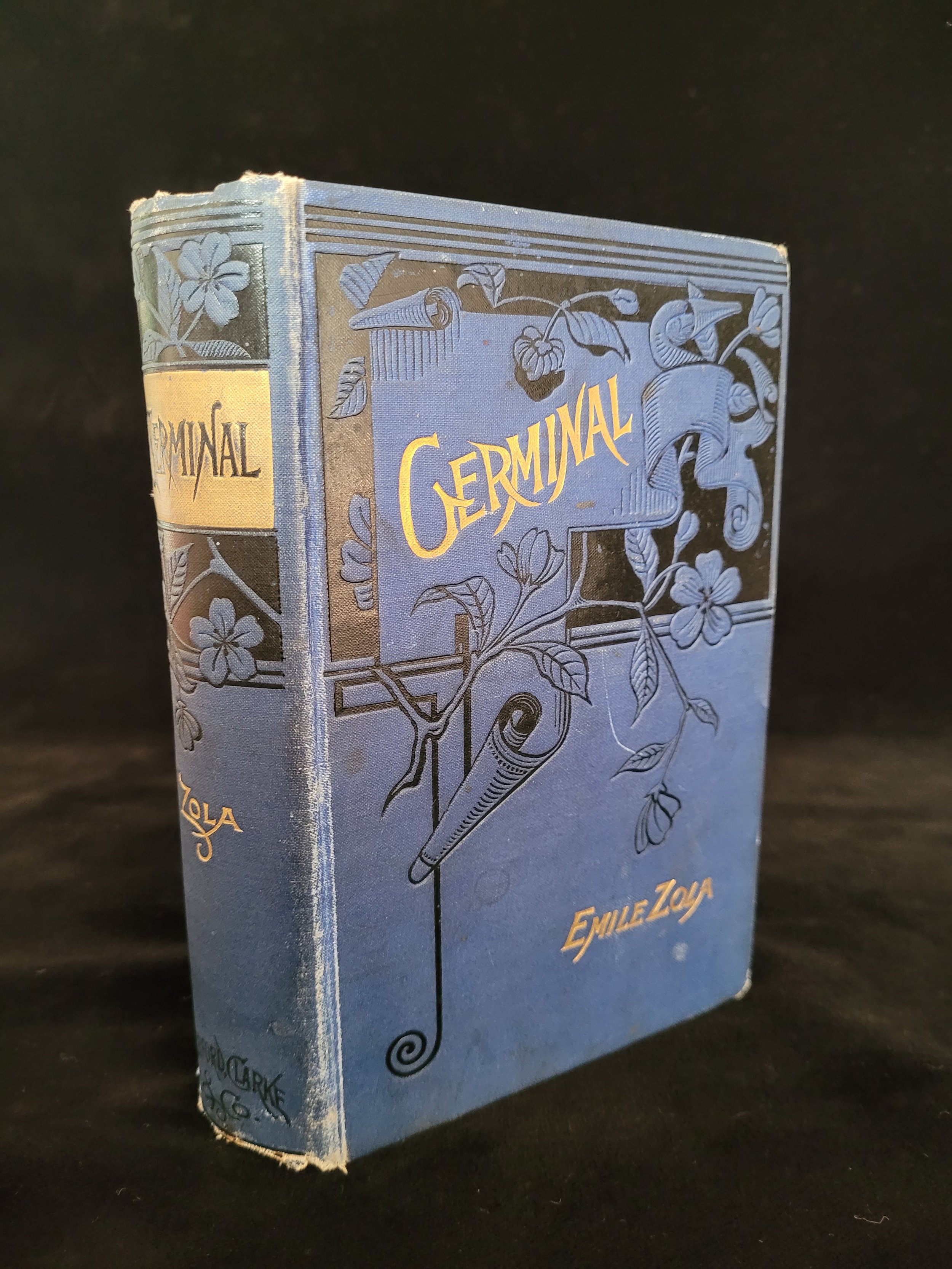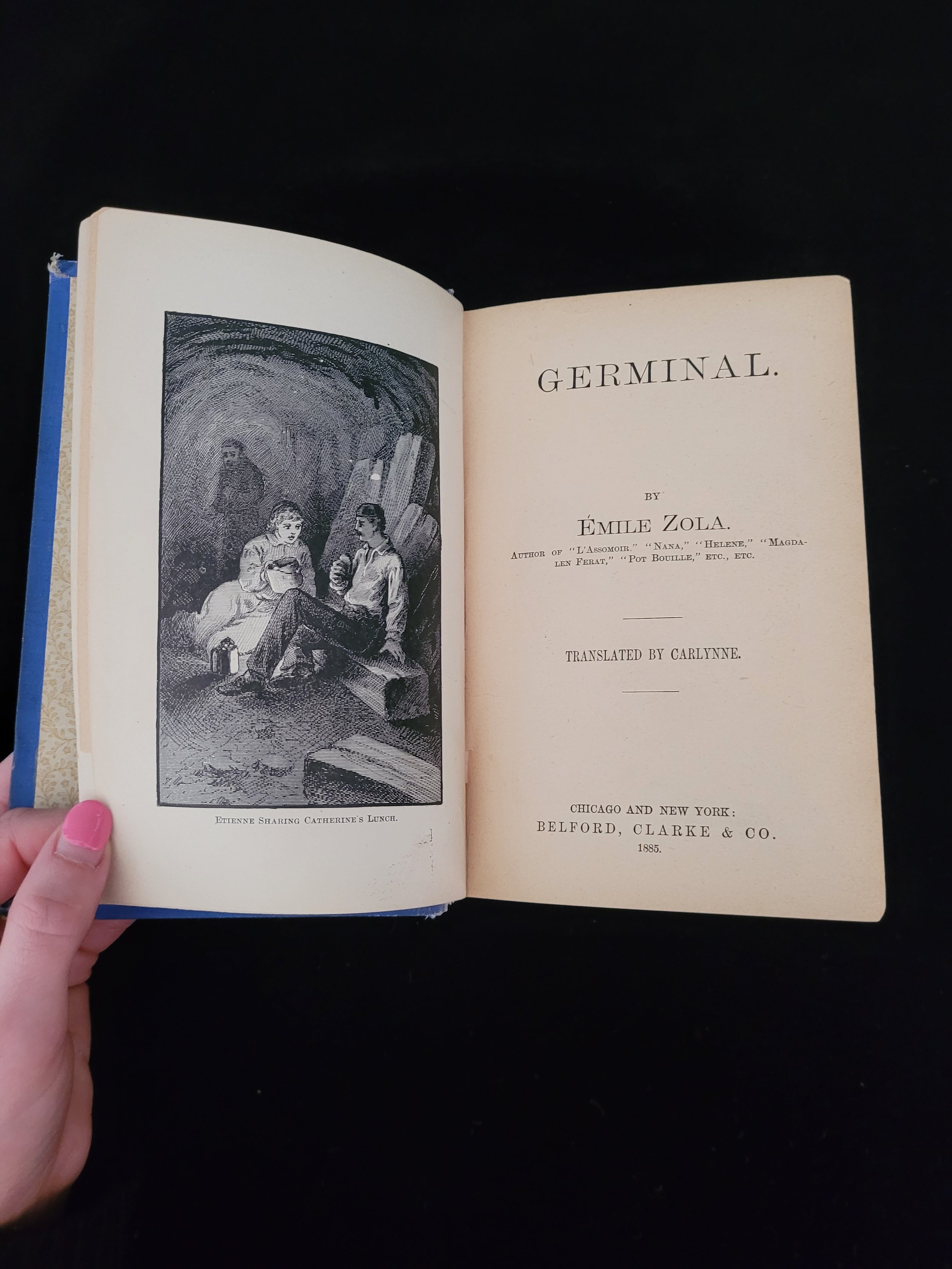 Image 1 of 2
Image 1 of 2

 Image 2 of 2
Image 2 of 2



Germinal. The First US edition.
ZOLA, Emile
Germinal. The First US edition.
Chicago and New York: Belford, Clarke & Co., 1885
8vo., original decorative blue cloth, typographically titled in gilt to upper board, decorated and embossed in black with florals and banner design, extending to spine; decorative gold printed label to backstrip, with publisher’s device in black to foot; decorative floral endpapers; pp. [iv], 5-435, [i]; with frontispice showing Etienne sharing Catherine’s lunch; a good to very good copy, scarce in the publisher’s binding, bumped to corners and rubbed along spine, a little fraying to cloth at the head and foot, showing through a little to the boards beneath; some small ink and paler stains to the rear board; cracked to the internal gutters, with a little binding webbing showing through beneath, sometime reinforced and holding firm; thin vertical chip to p. [i-ii], light marginal toning throughout, but otherwise clean; neat ownership name in faded ink to verso of frontis; the odd page with some nicking and short closed tears to internal gutter. Seldom found thus.
First US edition, and first illustrated, translated by Carlynne. Germinal was first written between April 1884 and January 1885, serialised between November 1884 and February 1885 in the periodical Gil Blas, and published in March 1885 by Charpentier in Paris. This American edition precedes the UK version, making it beyond reasonable doubt the first to be found in the English language. This variant in the navy blue binding (also found in other colours such as burnt orange, green and tan).
Germinal was Zola’s eighteenth novel within his twenty-volume series Les Rougon-Macquart, which follows the lives of members of the two titular branches of a fictional family living during the Second French Empire (1852–1870). Widely considered today to be his masterpiece, and certainly the best selling in both French and English, the story is particularly notable for its depiction of coalminer’s strikes in Northern France in the 1860s, described in a realistic and somewhat brutal manner. As part of his research, Zola travelled to several such towns including Anzin and Denian, and witnessed first hand the effects of the strikes, even venturing himself down a mining shaft. In a 1989 article written by Tom Wolfe (who idolised Zola), Wolfe describes Zola’s realisation that the horse which pulls the miner’s underground wagons is brought into the pits as a colt, and once down there, never returns: “When Zola transfers this revelation from the pages of his documentation notebook to the pages of Germinal, it makes the hair on your arms stand on end. You realize, without the need of amplification, that the horse is the miners themselves, who descend below the face of the earth as children and dig coal down in the pit until they can dig no more and then are buried, often literally, down there.”
The title of the book stems from Latin word ‘seed’, or german, as depicted in the final lines which describes the characters reaching towards the sun for a new and better life: “Men were sprouting; a black avenging army, still germinating in the furrows, was swelling for the harvests of the next century…” The book remains a popular work of French mining-town folklore today, and one which symbolises the cause of the working classes. It has been adapted for film five times, including as early as 1905, and as recently as 1993 by Claude Berri with Miou-Miou, Renaud, and Gérard Depardieu.
An important work of French fiction, portraying the exploitative brutality of human nature juxtaposed against the capacity for hope.
We can trace only a handful of copies in institutions worldwide, and no copy at auction within the last 50 years.
ZOLA, Emile
Germinal. The First US edition.
Chicago and New York: Belford, Clarke & Co., 1885
8vo., original decorative blue cloth, typographically titled in gilt to upper board, decorated and embossed in black with florals and banner design, extending to spine; decorative gold printed label to backstrip, with publisher’s device in black to foot; decorative floral endpapers; pp. [iv], 5-435, [i]; with frontispice showing Etienne sharing Catherine’s lunch; a good to very good copy, scarce in the publisher’s binding, bumped to corners and rubbed along spine, a little fraying to cloth at the head and foot, showing through a little to the boards beneath; some small ink and paler stains to the rear board; cracked to the internal gutters, with a little binding webbing showing through beneath, sometime reinforced and holding firm; thin vertical chip to p. [i-ii], light marginal toning throughout, but otherwise clean; neat ownership name in faded ink to verso of frontis; the odd page with some nicking and short closed tears to internal gutter. Seldom found thus.
First US edition, and first illustrated, translated by Carlynne. Germinal was first written between April 1884 and January 1885, serialised between November 1884 and February 1885 in the periodical Gil Blas, and published in March 1885 by Charpentier in Paris. This American edition precedes the UK version, making it beyond reasonable doubt the first to be found in the English language. This variant in the navy blue binding (also found in other colours such as burnt orange, green and tan).
Germinal was Zola’s eighteenth novel within his twenty-volume series Les Rougon-Macquart, which follows the lives of members of the two titular branches of a fictional family living during the Second French Empire (1852–1870). Widely considered today to be his masterpiece, and certainly the best selling in both French and English, the story is particularly notable for its depiction of coalminer’s strikes in Northern France in the 1860s, described in a realistic and somewhat brutal manner. As part of his research, Zola travelled to several such towns including Anzin and Denian, and witnessed first hand the effects of the strikes, even venturing himself down a mining shaft. In a 1989 article written by Tom Wolfe (who idolised Zola), Wolfe describes Zola’s realisation that the horse which pulls the miner’s underground wagons is brought into the pits as a colt, and once down there, never returns: “When Zola transfers this revelation from the pages of his documentation notebook to the pages of Germinal, it makes the hair on your arms stand on end. You realize, without the need of amplification, that the horse is the miners themselves, who descend below the face of the earth as children and dig coal down in the pit until they can dig no more and then are buried, often literally, down there.”
The title of the book stems from Latin word ‘seed’, or german, as depicted in the final lines which describes the characters reaching towards the sun for a new and better life: “Men were sprouting; a black avenging army, still germinating in the furrows, was swelling for the harvests of the next century…” The book remains a popular work of French mining-town folklore today, and one which symbolises the cause of the working classes. It has been adapted for film five times, including as early as 1905, and as recently as 1993 by Claude Berri with Miou-Miou, Renaud, and Gérard Depardieu.
An important work of French fiction, portraying the exploitative brutality of human nature juxtaposed against the capacity for hope.
We can trace only a handful of copies in institutions worldwide, and no copy at auction within the last 50 years.
ZOLA, Emile
Germinal. The First US edition.
Chicago and New York: Belford, Clarke & Co., 1885
8vo., original decorative blue cloth, typographically titled in gilt to upper board, decorated and embossed in black with florals and banner design, extending to spine; decorative gold printed label to backstrip, with publisher’s device in black to foot; decorative floral endpapers; pp. [iv], 5-435, [i]; with frontispice showing Etienne sharing Catherine’s lunch; a good to very good copy, scarce in the publisher’s binding, bumped to corners and rubbed along spine, a little fraying to cloth at the head and foot, showing through a little to the boards beneath; some small ink and paler stains to the rear board; cracked to the internal gutters, with a little binding webbing showing through beneath, sometime reinforced and holding firm; thin vertical chip to p. [i-ii], light marginal toning throughout, but otherwise clean; neat ownership name in faded ink to verso of frontis; the odd page with some nicking and short closed tears to internal gutter. Seldom found thus.
First US edition, and first illustrated, translated by Carlynne. Germinal was first written between April 1884 and January 1885, serialised between November 1884 and February 1885 in the periodical Gil Blas, and published in March 1885 by Charpentier in Paris. This American edition precedes the UK version, making it beyond reasonable doubt the first to be found in the English language. This variant in the navy blue binding (also found in other colours such as burnt orange, green and tan).
Germinal was Zola’s eighteenth novel within his twenty-volume series Les Rougon-Macquart, which follows the lives of members of the two titular branches of a fictional family living during the Second French Empire (1852–1870). Widely considered today to be his masterpiece, and certainly the best selling in both French and English, the story is particularly notable for its depiction of coalminer’s strikes in Northern France in the 1860s, described in a realistic and somewhat brutal manner. As part of his research, Zola travelled to several such towns including Anzin and Denian, and witnessed first hand the effects of the strikes, even venturing himself down a mining shaft. In a 1989 article written by Tom Wolfe (who idolised Zola), Wolfe describes Zola’s realisation that the horse which pulls the miner’s underground wagons is brought into the pits as a colt, and once down there, never returns: “When Zola transfers this revelation from the pages of his documentation notebook to the pages of Germinal, it makes the hair on your arms stand on end. You realize, without the need of amplification, that the horse is the miners themselves, who descend below the face of the earth as children and dig coal down in the pit until they can dig no more and then are buried, often literally, down there.”
The title of the book stems from Latin word ‘seed’, or german, as depicted in the final lines which describes the characters reaching towards the sun for a new and better life: “Men were sprouting; a black avenging army, still germinating in the furrows, was swelling for the harvests of the next century…” The book remains a popular work of French mining-town folklore today, and one which symbolises the cause of the working classes. It has been adapted for film five times, including as early as 1905, and as recently as 1993 by Claude Berri with Miou-Miou, Renaud, and Gérard Depardieu.
An important work of French fiction, portraying the exploitative brutality of human nature juxtaposed against the capacity for hope.
We can trace only a handful of copies in institutions worldwide, and no copy at auction within the last 50 years.

